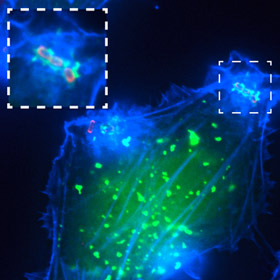 A new study from the group of Prof. Vassilis Koronakis has just been published in PNAS. Salmonella causes many different diseases including gastroenteritis and typhoid fever. For infection to take place Salmonella has to enter the epithelium in the gut by injecting a number of effector proteins that trigger dramatic actin rearrangements and membrane ruffles that engulf the pathogen. Graduated PhD student from the Department of Pathology Dr. Andrew Brooks identified a myosin motor protein as a crucial host protein that are targeted by two Salmonella virulence effector proteins, SopE and SopB, at the onset of infection. SopE and SopB hijack myosin VI to facilitate membrane ruffle formation and phospholipid production at the invasion site to mediate pathogen uptake. Myosin motors are highly druggable targets and therefore myosin inhibitors are attractive new tools to fight bacterial infections.
A new study from the group of Prof. Vassilis Koronakis has just been published in PNAS. Salmonella causes many different diseases including gastroenteritis and typhoid fever. For infection to take place Salmonella has to enter the epithelium in the gut by injecting a number of effector proteins that trigger dramatic actin rearrangements and membrane ruffles that engulf the pathogen. Graduated PhD student from the Department of Pathology Dr. Andrew Brooks identified a myosin motor protein as a crucial host protein that are targeted by two Salmonella virulence effector proteins, SopE and SopB, at the onset of infection. SopE and SopB hijack myosin VI to facilitate membrane ruffle formation and phospholipid production at the invasion site to mediate pathogen uptake. Myosin motors are highly druggable targets and therefore myosin inhibitors are attractive new tools to fight bacterial infections.
http://www.pnas.org/content/early/2017/03/21/1616418114.long
Brooks AB, Humphreys D*, Singh V, Davidson AC, Arden SD, Buss F, Koronakis V. Proc Natl Acad Sci USA. 2017 Mar 27. [Epub ahead of print]

